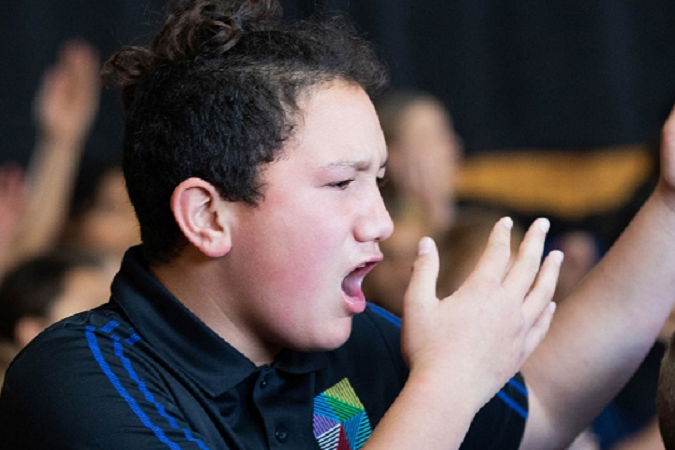Te reo kori me te nekehanga - Voice and movement
This activity collection, "Te reo kori me te nekehanga - Voice and movement", is part of the resource collection Te Ao Kori.

About this resource
This teaching and planning activity resource collection has instructions that help kaiako support ākonga in choreographing and performing waiata-ā-ringa (action songs) and composing and performing a haka.
Kaiako can adapt and develop activities from "Te reo kori me te nekehanga - Voice and movement" collection (years 1–13), which is part of the resource collection Te Ao Kori, to meet the identified learning needs of ākonga.
Te reo kori me te nekehanga
Voice and movement: Activity collection

Explore the resource collection, Te Ao Kori
This activity resource collection, "Te reo kori me te nekehanga - Voice and movement ", is part of the resource collection Te Ao Kori.
Te reo kori me te nekehanga - Voice and movement collection
Background information
Te Ao Kori collection
Tātaiako cultural competencies for teachers of Māori learners
Include hapū, iwi, and tangata whenua
Techniques, tikanga, and waiata for te reo kori me te nekehanga (voice and movement) vary between hapū and iwi. Acknowledging tangata whenua, and ensuring that your chosen waiata and actions are authentic to your area can begin with conversations and partnerships with ākonga and whānau who bring expertise to the classroom. If you have no Māori whānau, or hapū or iwi connections, within your school, seek introductions to Māori communities through Kāhui ako/school networks, or talk to the strategic advisor Māori at your regional Ministry of Education office.
Whakapapa
There are many different explanations of haka; this is one of them.
The term whakapapa derives from the word papa meaning layers or levels. In this sense, it shows the various genealogical layers and lines of descent that create personal identity and links between whānau, hapū, and iwi.
- Tamanuiterā - the sun
- Hineraumati - summer maiden
- Hinetakurua - winter maiden
- Tāne Rore - the prince of haka, also known as Tamarore
In celebration of the coming of summer, Tāne Rore personified the many forms of posture, dances and movement. He quivered his hands to represent the shimmering heat waves given off Papatūānuku (Earth Mother) when heated by his ancestor Tamanuiterā in the summer season (Raumati). The wiri (quivering of the hands) is an integral part of Māori movement, seen in haka, as well as making the movements deceptive, which is essential in the arts of combat.
The haka pre-dates the arrival of the earliest Pākehā explorers and settlers in Aotearoa New Zealand. Forms of haka have existed throughout Polynesia, Micronesia, and Melanesia throughout time. Early observations have recorded that there were many types of haka performed in different styles and formations and for different purposes. It is said that there are up to sixteen different types of haka that are known. While some may be very similar, they each have their own distinct features and uses. These range from the haka waiata – the forerunner to the modern action song – to haka pīrori – a haka of revenge and contempt.
The words of the haka describe thoughts and emotions and do not just deal with warfare and exhortation, welcome and farewell. Haka can express grievance or complaint, description of an event, triumph at escape from capture – the reasons are endless.
Common usage today often restricts the term "haka" to the following types: haka taparahi, haka peruperu, haka pōwhiri, haka ngeri, and haka manawa wera.
The haka Tāne Rore was expressly composed to teach ākonga the philosophy and tradition of the haka. It describes the whakapapa (history and protocols) and the gift of haka by Tāne Rore. It refers to stance and how the whole body should be involved, including the face, eyes, and the protruding of the tongue (for the male only). The words are essential to express the thoughts and should be the primary focus.
(The National Heart Foundation of New Zealand, 1998)
Tikanga
Hapū and iwi have different rules/practices related to stance. It is recommended that kaiako seek guidance from their Māori community to ensure authenticity and cultural appropriateness of haka.
Te reo Māori vocabulary
- Āta tū – stance standing still
- Hope – hands on hips
- Kia mau – take your stance
- Kia rite – get ready
- Kia wiri – start your hands quivering
- Kupu – words
- Ringaringa – hands
- Waewae – feet/legs
- Whatu/karu – eyes
- Pūkana – wide opening of the eyes and dilating of the pupils (men and women)
- Ringa whiua – swing arms across body
- Takahia – use the takahi step
- Arero – tongue
- Te ihi – inner feelings
- Tinana – body
- Wairua – spirit
- Waewae takahia – commence beating the right foot
- Whātero/whētero – sticking out the tongue (men only)
- Wiri – quivering of the hands











